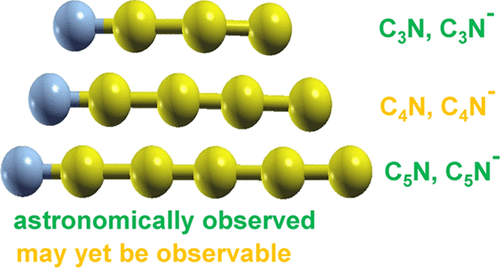当前位置:
X-MOL 学术
›
ACS Earth Space Chem.
›
论文详情
Our official English website, www.x-mol.net, welcomes your
feedback! (Note: you will need to create a separate account there.)
Extensive Quantum Chemistry Study of Neutral and Charged C4N Chains: An Attempt To Aid Astronomical Observations
ACS Earth and Space Chemistry ( IF 2.9 ) Pub Date : 2020-02-25 , DOI: 10.1021/acsearthspacechem.9b00321 Ioan Bâldea 1, 2
ACS Earth and Space Chemistry ( IF 2.9 ) Pub Date : 2020-02-25 , DOI: 10.1021/acsearthspacechem.9b00321 Ioan Bâldea 1, 2
Affiliation

|
Many molecular species can presumably still be observed in space if they are adequately characterized chemically. In this paper, we suggest that this could be the case of the neutral (C4N0) and anion (C4N–) cyanopropynylidene chains, which were not yet identified in space although both the neutral (C3N0 and C5N0) and anion (C3N– and C5N–) neighboring members of the homologous series were observed. Extensive data obtained from quantum chemical calculations using density functional theory (DFT), coupled-cluster (CC), and quadratic configuration interaction (QCI) methods for all charge and spin states of interest for space science (doublet and quartet neutrals, triplet and singlet anions, and singlet and triplet cations) are reported, e.g., bond metric and natural bond order data, enthalpies of formation, dissociation and reaction energies, spin gaps, rotational constants, vibrational properties, dipole and quadrupole moments, electron attachment energies (EAs), and ionization potentials (IPs). The fact that (not only for C4N but also for C2N and C6N) the quantum chemical methods utilized here are able to excellently reproduce the experimental EA value, which is often a challenge for theory, is particularly encouraging, since this indicates that theoretical estimates of chemical reactivity indices (which are key input parameters for modeling astrochemical evolution) can be trusted. The presently calculated enthalpies of formation and dissociation energies do not substantiate any reason to assume that C4N is absent in space. To further support this idea, we analyze potential chemical pathways of formation of both C4N0 and C4N–, which include association and exchange reactions. In view of the substantially larger dipole moment (Danion ≫ Dneutral), we suggest that astronomical detection should first focus on C4N– chains rather than on neutral C4N0 chains.
中文翻译:

中性和带电C 4 N链的广泛量子化学研究:试图帮助天文观测
如果对它们进行了充分的化学表征,那么可能仍可以在太空中观察到许多分子种类。在本文中,我们建议可能是中性(C 4 N 0)和阴离子(C 4 N –)氰基亚丙基链的情况,尽管中性(C 3 N 0和C 5 N 0)和阴离子(C 3 N –和C 5 N –)观察到同源序列的相邻成员。使用密度泛函理论(DFT),耦合簇(CC)和二次配置相互作用(QCI)方法从量子化学计算获得的大量数据,涉及空间科学中所有感兴趣的电荷和自旋态(双峰和四重态中性,三重态和单重态)阴离子,以及单线和三线态阳离子),例如,键度量和自然键序数据,形成焓,解离和反应能,自旋间隙,旋转常数,振动特性,偶极和四极矩,电子附着能(EA) ,以及电离电势(IPs)。(不仅对于C 4 N,而且对于C 2 N和C 6N)此处使用的量子化学方法能够出色地重现实验EA值,这通常是理论上的挑战,这尤其令人鼓舞,因为这表明化学反应性指数的理论估计(这是模拟天化学演化的关键输入参数) )可以信任。目前计算出的形成能和离解能的焓并不能证明假设C 4 N在空间中不存在的任何理由。为了进一步支持该想法,我们分析了C 4 N 0和C 4 N –形成的潜在化学途径,包括缔合和交换反应。鉴于大得多的偶极矩(D阴离子≫ D中性),我们建议天文学检测应首先关注C 4 N –链,而不是中性C 4 N 0链。
更新日期:2020-02-25
中文翻译:

中性和带电C 4 N链的广泛量子化学研究:试图帮助天文观测
如果对它们进行了充分的化学表征,那么可能仍可以在太空中观察到许多分子种类。在本文中,我们建议可能是中性(C 4 N 0)和阴离子(C 4 N –)氰基亚丙基链的情况,尽管中性(C 3 N 0和C 5 N 0)和阴离子(C 3 N –和C 5 N –)观察到同源序列的相邻成员。使用密度泛函理论(DFT),耦合簇(CC)和二次配置相互作用(QCI)方法从量子化学计算获得的大量数据,涉及空间科学中所有感兴趣的电荷和自旋态(双峰和四重态中性,三重态和单重态)阴离子,以及单线和三线态阳离子),例如,键度量和自然键序数据,形成焓,解离和反应能,自旋间隙,旋转常数,振动特性,偶极和四极矩,电子附着能(EA) ,以及电离电势(IPs)。(不仅对于C 4 N,而且对于C 2 N和C 6N)此处使用的量子化学方法能够出色地重现实验EA值,这通常是理论上的挑战,这尤其令人鼓舞,因为这表明化学反应性指数的理论估计(这是模拟天化学演化的关键输入参数) )可以信任。目前计算出的形成能和离解能的焓并不能证明假设C 4 N在空间中不存在的任何理由。为了进一步支持该想法,我们分析了C 4 N 0和C 4 N –形成的潜在化学途径,包括缔合和交换反应。鉴于大得多的偶极矩(D阴离子≫ D中性),我们建议天文学检测应首先关注C 4 N –链,而不是中性C 4 N 0链。











































 京公网安备 11010802027423号
京公网安备 11010802027423号